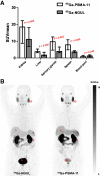Head-to-Head Comparison of 68Ga-NOTA (68Ga-NGUL) and 68Ga-PSMA-11 in Patients with Metastatic Prostate Cancer: A Prospective Study
- PMID: 33637585
- PMCID: PMC8724887
- DOI: 10.2967/jnumed.120.258434
Head-to-Head Comparison of 68Ga-NOTA (68Ga-NGUL) and 68Ga-PSMA-11 in Patients with Metastatic Prostate Cancer: A Prospective Study
Abstract
68Ga-NOTA Glu-Urea-Lys (NGUL) is a novel prostate-specific membrane antigen (PSMA)-targeting tracer used for PET/CT imaging. This study aimed to compare performance in the detection of primary and metastatic lesions and to compare biodistribution between 68Ga-NGUL and 68Ga-PSMA-11 in the same patients with prostate cancer. Methods: Eleven patients with metastatic prostate cancer were prospectively recruited. The quantitative tracer uptake was determined in normal organs and in primary and metastatic lesions. Results:68Ga-NGUL showed significantly lower normal-organ uptake and rapid urinary clearance. The number and sites of detected PSMA-positive primary and metastatic lesions were identical, and no significant quantitative uptake difference was observed. 68Ga-NGUL showed a relatively lower tumor-to-background ratio than 68Ga-PSMA-11. Conclusion: In a head-to-head comparison with 68Ga-PSMA-11, 68Ga-NGUL showed lower uptake in normal organs and similar performance in detecting PSMA-avid primary and metastatic lesions. 68Ga-NGUL could be a valuable option for PSMA imaging.
Keywords: 68Ga-NGUL; 68Ga-PSMA-11; biodistribution; prostate-specific membrane antigen.
© 2021 by the Society of Nuclear Medicine and Molecular Imaging.
Figures




Similar articles
-
Phase I Clinical Trial of Prostate-Specific Membrane Antigen-Targeting 68Ga-NGUL PET/CT in Healthy Volunteers and Patients with Prostate Cancer.Korean J Radiol. 2022 Sep;23(9):911-920. doi: 10.3348/kjr.2022.0176. Epub 2022 Jun 20. Korean J Radiol. 2022. PMID: 35762185 Free PMC article. Clinical Trial.
-
Early Injection of Furosemide Increases Detection Rate of Local Recurrence in Prostate Cancer Patients with Biochemical Recurrence Referred for 68Ga-PSMA-11 PET/CT.J Nucl Med. 2021 Nov;62(11):1550-1557. doi: 10.2967/jnumed.120.261866. Epub 2021 Mar 12. J Nucl Med. 2021. PMID: 33712533 Free PMC article.
-
Matched-Pair Comparison of 68Ga-PSMA-11 and 18F-rhPSMA-7 PET/CT in Patients with Primary and Biochemical Recurrence of Prostate Cancer: Frequency of Non-Tumor-Related Uptake and Tumor Positivity.J Nucl Med. 2021 Aug 1;62(8):1082-1088. doi: 10.2967/jnumed.120.251447. Epub 2020 Dec 4. J Nucl Med. 2021. PMID: 33277394
-
68Ga-Labeled Prostate-specific Membrane Antigen Ligand Positron Emission Tomography/Computed Tomography for Prostate Cancer: A Systematic Review and Meta-analysis.Eur Urol Focus. 2018 Sep;4(5):686-693. doi: 10.1016/j.euf.2016.11.002. Epub 2016 Nov 15. Eur Urol Focus. 2018. PMID: 28753806
-
68Ga-PSMA PET/CT in prostate cancer.Rev Esp Med Nucl Imagen Mol (Engl Ed). 2018 Mar-Apr;37(2):130-138. doi: 10.1016/j.remn.2017.07.004. Epub 2017 Sep 21. Rev Esp Med Nucl Imagen Mol (Engl Ed). 2018. PMID: 28941866 Review. English, Spanish.
Cited by
-
MR Molecular Imaging of Extradomain-B Fibronectin for Assessing Progression and Therapy Resistance of Prostate Cancer.Chem Biomed Imaging. 2024 Jun 11;2(8):560-568. doi: 10.1021/cbmi.4c00002. eCollection 2024 Aug 26. Chem Biomed Imaging. 2024. PMID: 39211789 Free PMC article.
-
Phase I Clinical Trial of Prostate-Specific Membrane Antigen-Targeting 68Ga-NGUL PET/CT in Healthy Volunteers and Patients with Prostate Cancer.Korean J Radiol. 2022 Sep;23(9):911-920. doi: 10.3348/kjr.2022.0176. Epub 2022 Jun 20. Korean J Radiol. 2022. PMID: 35762185 Free PMC article. Clinical Trial.
-
Design, preclinical evaluation, and first-in-human PET study of [68Ga]Ga-PSFA-01: a PSMA/FAP heterobivalent tracer.Eur J Nucl Med Mol Imaging. 2025 Feb;52(3):1166-1176. doi: 10.1007/s00259-024-06965-7. Epub 2024 Nov 9. Eur J Nucl Med Mol Imaging. 2025. PMID: 39520516 Clinical Trial.
-
Current Status of PSMA-Targeted Radioligand Therapy in the Era of Radiopharmaceutical Therapy Acquiring Marketing Authorization.Nucl Med Mol Imaging. 2022 Dec;56(6):263-281. doi: 10.1007/s13139-022-00764-4. Epub 2022 Aug 20. Nucl Med Mol Imaging. 2022. PMID: 36425273 Free PMC article. Review.
-
A prospective head-to-head comparison of [68Ga]Ga-P16-093 and [68Ga]Ga-PSMA-11 PET/CT in patients with primary prostate cancer.Eur J Nucl Med Mol Imaging. 2023 Aug;50(10):3126-3136. doi: 10.1007/s00259-023-06283-4. Epub 2023 May 26. Eur J Nucl Med Mol Imaging. 2023. PMID: 37233785 Free PMC article. Clinical Trial.
References
-
- Iravani A, Violet J, Azad A, Hofman MS. Lutetium-177 prostate-specific membrane antigen (PSMA) theranostics: practical nuances and intricacies. Prostate Cancer Prostatic Dis. 2020;23:38–52. - PubMed
-
- Siva S, Udovicich C, Tran B, Zargar H, Murphy DG, Hofman MS. Expanding the role of small-molecule PSMA ligands beyond PET staging of prostate cancer. Nat Rev Urol. 2020;17:107–118. - PubMed
-
- Eder M, Schafer M, Bauder-Wust U, et al. . 68Ga-complex lipophilicity and the targeting property of a urea-based PSMA inhibitor for PET imaging. Bioconjug Chem. 2012;23:688–697. - PubMed
-
- Ceci F, Uprimny C, Nilica B, et al. . 68Ga-PSMA PET/CT for restaging recurrent prostate cancer: which factors are associated with PET/CT detection rate? Eur J Nucl Med Mol Imaging. 2015;42:1284–1294. - PubMed
-
- Fendler WP, Eiber M, Beheshti M, et al. . 68Ga-PSMA PET/CT: joint EANM and SNMMI procedure guideline for prostate cancer imaging: version 1.0. Eur J Nucl Med Mol Imaging. 2017;44:1014–1024. - PubMed
Publication types
MeSH terms
Substances
LinkOut - more resources
Full Text Sources
Other Literature Sources
Medical
Miscellaneous
